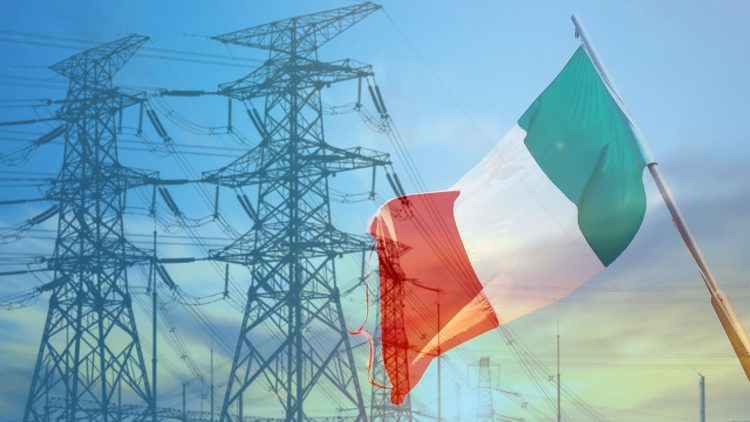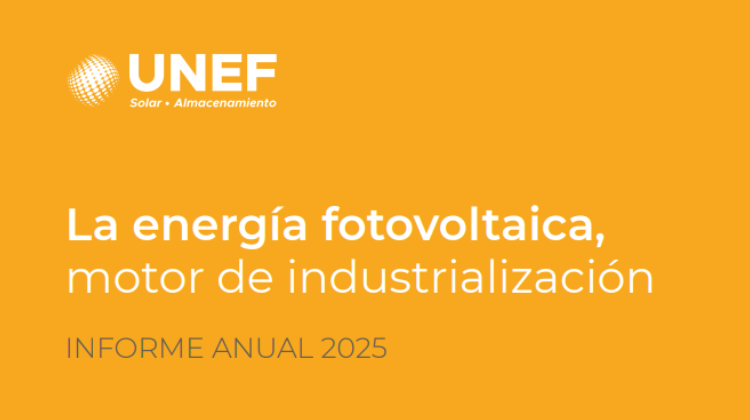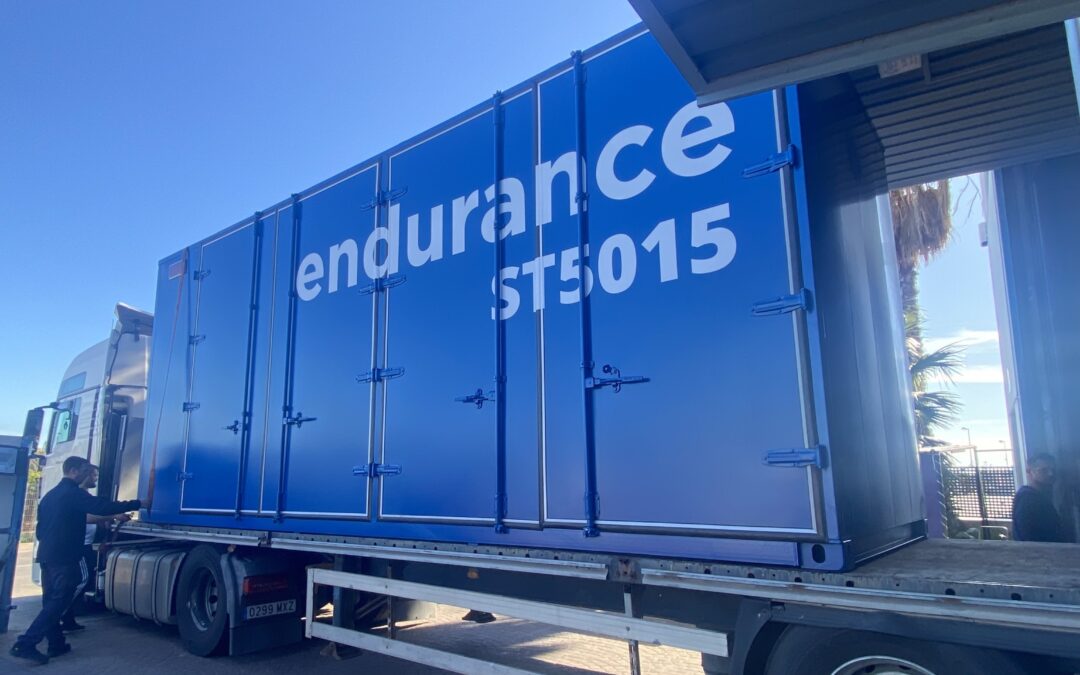The Lithuanian National Energy Regulatory Council (VERT) has launched a tendering process for the construction of a 700 MW offshore wind farm in the Baltic Sea, aiming for it to be operational by 2033.












The Lithuanian National Energy Regulatory Council (VERT) has launched a tendering process for the construction of a 700 MW offshore wind farm in the Baltic Sea, aiming for it to be operational by 2033.

Poland sets a record in renewable energy development with over 4,100 projects having grid connection conditions. These include 19 GW of photovoltaic energy and 2.7 GW of wind energy, some with construction permits to participate in auctions. The country is progressing towards its goal of 30 GW of installed capacity by 2030.

The IRENA report reveals the challenges in meeting the goals of the Paris Agreement. From outdated infrastructure to investment inequality, the challenges that hinder the global energy transition are identified, along with key proposals for structural change.The transition to a sustainable global energy system faces multiple barriers that jeopardize the goals of the Paris Agreement and the target of limiting global warming to 1.5°C. According to the “World Energy Transition Outlook 2024” report from the International Renewable Energy Agency (IRENA), achieving these goals requires tripling installed renewable capacity and doubling energy efficiency by 2030. However, structural, financial, and technological barriers continue to be significant challenges.
**Structural Barriers and Global Inequality**
One of the main limitations is outdated energy infrastructure, designed for fossil fuels. “Modernizing the power grids is essential to integrate renewable energy at a large scale,” the report emphasizes. In addition, the lack of adequate regulatory frameworks and insufficient energy planning creates uncertainty for investors, hindering the transition.
Another critical issue is the inequality in access to financing and clean technologies. In 2023, advanced economies accounted for 47% of global investment in renewable energy, while over 150 developing countries, which represent half of the world’s population, received only 10%. “This perpetuates energy inequalities and limits development opportunities in the Global South,” the report outlines.
**The Challenge of International Financing**
International financing plays a decisive role in closing this gap. “It is crucial to channel resources to countries with the greatest need and potential for renewable energy, especially in Africa,” the IRENA report states. However, high initial costs, along with perceived risks in emerging markets, make it difficult to mobilize private capital.
To address these challenges, the report proposes mechanisms such as the new Quantified Collective Goal (NCQG), which will be debated at COP29, and risk-reducing strategies that facilitate private investment. “Public funding must act as a catalyst to reduce risks and attract private capital,” IRENA emphasizes.
**Geographical Concentration of Investment**
Another highlighted obstacle is the geographical concentration of renewable energy investment. While economies like China, the United States, and Brazil lead in investment, less-developed countries face significant difficulties. “Despite their high renewable resource potential, African countries are unable to attract significant financial flows,” the report adds.
This disparity has serious implications: it limits access to clean energy, reduces the global impact on the fight against climate change, and perpetuates an unequal energy transition. Therefore, IRENA stresses the need to develop strong regulatory frameworks and increase international collaboration to mobilize resources toward the Global South.
**COP28 Goals and the Path to 2030**
COP28, held in Dubai, set ambitious targets for 2030, including tripling global installed renewable energy capacity and doubling energy efficiency. These commitments aim to decarbonize the global energy system and limit warming to 1.5°C.
To achieve this, solar photovoltaic capacity will need to be quadrupled, reaching 5,457 GW by 2030, and electrifying sectors such as transportation, industry, and construction will be crucial. “These goals require coordinated action between governments, businesses, and investors, along with an economic structural shift,” the report states.
**Overcoming Barriers in the Global Energy Transition** is essential to ensure a sustainable, equitable, and prosperous future. The IRENA report makes it clear that international collaboration, inclusive financing, and the development of modern infrastructure are key to closing the gap between developed and developing countries. As the document states, “A just and inclusive energy transition is not only a climate imperative but also an opportunity to transform the global economy.”

The goals set are significant both in scope and impact, with a focus on key areas such as carbon emission reduction, energy efficiency, resource management, and biodiversity.

With record renewable generation, clear objectives for 2030, and strong demands from the sector, Sara Aagesen takes on the portfolio with an agenda that prioritizes electrification, decarbonization, and social justice, in line with Teresa Ribera’s legacy.

With 1,238.4 MW in environmental processing published in November, wind energy leads with 596.6 MW, followed by agrivoltaics with 528.8 MW. However, four projects totaling 159.6 MW were rejected in the environmental impact assessment, highlighting the regulatory challenges in the sector.

The Polish energy market is at a turning point: while fluctuating prices reignite interest in auctions, investors are carefully weighing the benefits and risks of this mechanism against alternatives like long-term power purchase agreements.

A significant portion of the sector has highlighted the technical expertise and continuity that the current Secretary of Energy’s appointment as Third Vice President and Minister will bring with optimism. They also review the key challenges she will need to address: nuclear energy, auctions, tenders, self-consumption regulations, storage, biogases, among others.

During the Offshore Wind Poland 2024 Conference, the Polish government announced the designation of new areas in the Baltic Sea for offshore wind development, strengthening a sector that could reach 33 GW of installed capacity and meet 60% of the country’s energy demand.

The Council of State of Italy has provisionally suspended a key provision of the Suitable Areas Decree, limiting the ability of Italian regions to impose stricter regulations. The measure, effective until the hearing in February 2025, creates uncertainty in the development and processing of renewable energy projects. Lawyers analyze the ruling in a conversation with Energía Estratégica España.

The excess of renewable generation and the lack of clear policies for energy storage are creating uncertainty in the market. Industry experts highlight the urgent need for regulation to ensure the financial viability of new projects and stabilize prices.

The Prime Minister of the United Kingdom, Keir Starmer, launched the Global Clean Energy Alliance during the G20 summit in Rio de Janeiro, bringing 12 countries into this initiative. The alliance aims to accelerate the energy transition, promote global energy security, and create thousands of jobs.

According to recent data from Terna, grid connection requests for renewable projects in Italy exceed 300 GW. This phenomenon reflects the pressure of industrial convenience and public planning, notes Alessandro Visalli, who explains that the lack of technical requirements for applications creates virtual grid saturation with a large number of projects unlikely to result in operational plants.

QAIR Renewables Ibérica and the IREC Foundation lead the processing of three offshore wind farms in Galicia and Catalonia, with a total capacity of 1,758 MW, reinforcing the commitment to energy transition and floating technologies in Spain.

In Poland, internationally renowned companies have posted more than 20 job openings in the renewable energy and sustainability sector. The positions cover key roles in cities such as Warsaw, Krakow, and Gdynia, reflecting the growth of this sector in the country.

A Wood Mackenzie analysis warns that renewable energy will remain competitive, protectionism will increase, and it is unlikely that the Inflation Reduction Act (IRA) will be completely repealed.

The growing demand for data centers forces Europe to harmonize the digital and energy transition. David Redoli Morchón, from Solaria, highlights how regulations and national planning are key to a competitive and sustainable future.

Combined cycle plants gain prominence: their production increases by 43.5% and they dominate price setting. The cold and calm start to November tests the European energy market, causing a sharp rise in gas and electricity prices for 2025. Forecast for the end of the month: the expected increase in wind generation should moderate prices.

Spain designs a tax on energy companies but with incentives for decarbonization: reactions and political stances.

With a strong interest in participating in upcoming auctions in Iberia, Saitec Offshore Technologies is driving floating offshore wind in the region through key projects such as DemoSATH, GEROA, and Medfloat. The company highlights the value of these initiatives in reducing costs and promoting the energy transition offshore.

ZOOZ Power is a pioneer in ultra-fast charging systems for electric vehicles, focusing on renewable energy and optimized grid management. Its ZOOZTER-100 solution enables energy storage and enhancement for fast charging, facilitating integration into European markets and overcoming grid limitations without costly upgrades.

The Lithuanian National Energy Regulatory Council (VERT) has launched a tendering process for the construction of a 700 MW offshore wind farm in the Baltic Sea, aiming for it to be operational by 2033.

Poland sets a record in renewable energy development with over 4,100 projects having grid connection conditions. These include 19 GW of photovoltaic energy and 2.7 GW of wind energy, some with construction permits to participate in auctions. The country is progressing towards its goal of 30 GW of installed capacity by 2030.

The IRENA report reveals the challenges in meeting the goals of the Paris Agreement. From outdated infrastructure to investment inequality, the challenges that hinder the global energy transition are identified, along with key proposals for structural change.The transition to a sustainable global energy system faces multiple barriers that jeopardize the goals of the Paris Agreement and the target of limiting global warming to 1.5°C. According to the “World Energy Transition Outlook 2024” report from the International Renewable Energy Agency (IRENA), achieving these goals requires tripling installed renewable capacity and doubling energy efficiency by 2030. However, structural, financial, and technological barriers continue to be significant challenges.
**Structural Barriers and Global Inequality**
One of the main limitations is outdated energy infrastructure, designed for fossil fuels. “Modernizing the power grids is essential to integrate renewable energy at a large scale,” the report emphasizes. In addition, the lack of adequate regulatory frameworks and insufficient energy planning creates uncertainty for investors, hindering the transition.
Another critical issue is the inequality in access to financing and clean technologies. In 2023, advanced economies accounted for 47% of global investment in renewable energy, while over 150 developing countries, which represent half of the world’s population, received only 10%. “This perpetuates energy inequalities and limits development opportunities in the Global South,” the report outlines.
**The Challenge of International Financing**
International financing plays a decisive role in closing this gap. “It is crucial to channel resources to countries with the greatest need and potential for renewable energy, especially in Africa,” the IRENA report states. However, high initial costs, along with perceived risks in emerging markets, make it difficult to mobilize private capital.
To address these challenges, the report proposes mechanisms such as the new Quantified Collective Goal (NCQG), which will be debated at COP29, and risk-reducing strategies that facilitate private investment. “Public funding must act as a catalyst to reduce risks and attract private capital,” IRENA emphasizes.
**Geographical Concentration of Investment**
Another highlighted obstacle is the geographical concentration of renewable energy investment. While economies like China, the United States, and Brazil lead in investment, less-developed countries face significant difficulties. “Despite their high renewable resource potential, African countries are unable to attract significant financial flows,” the report adds.
This disparity has serious implications: it limits access to clean energy, reduces the global impact on the fight against climate change, and perpetuates an unequal energy transition. Therefore, IRENA stresses the need to develop strong regulatory frameworks and increase international collaboration to mobilize resources toward the Global South.
**COP28 Goals and the Path to 2030**
COP28, held in Dubai, set ambitious targets for 2030, including tripling global installed renewable energy capacity and doubling energy efficiency. These commitments aim to decarbonize the global energy system and limit warming to 1.5°C.
To achieve this, solar photovoltaic capacity will need to be quadrupled, reaching 5,457 GW by 2030, and electrifying sectors such as transportation, industry, and construction will be crucial. “These goals require coordinated action between governments, businesses, and investors, along with an economic structural shift,” the report states.
**Overcoming Barriers in the Global Energy Transition** is essential to ensure a sustainable, equitable, and prosperous future. The IRENA report makes it clear that international collaboration, inclusive financing, and the development of modern infrastructure are key to closing the gap between developed and developing countries. As the document states, “A just and inclusive energy transition is not only a climate imperative but also an opportunity to transform the global economy.”

The goals set are significant both in scope and impact, with a focus on key areas such as carbon emission reduction, energy efficiency, resource management, and biodiversity.

With record renewable generation, clear objectives for 2030, and strong demands from the sector, Sara Aagesen takes on the portfolio with an agenda that prioritizes electrification, decarbonization, and social justice, in line with Teresa Ribera’s legacy.

With 1,238.4 MW in environmental processing published in November, wind energy leads with 596.6 MW, followed by agrivoltaics with 528.8 MW. However, four projects totaling 159.6 MW were rejected in the environmental impact assessment, highlighting the regulatory challenges in the sector.

The Polish energy market is at a turning point: while fluctuating prices reignite interest in auctions, investors are carefully weighing the benefits and risks of this mechanism against alternatives like long-term power purchase agreements.

A significant portion of the sector has highlighted the technical expertise and continuity that the current Secretary of Energy’s appointment as Third Vice President and Minister will bring with optimism. They also review the key challenges she will need to address: nuclear energy, auctions, tenders, self-consumption regulations, storage, biogases, among others.

During the Offshore Wind Poland 2024 Conference, the Polish government announced the designation of new areas in the Baltic Sea for offshore wind development, strengthening a sector that could reach 33 GW of installed capacity and meet 60% of the country’s energy demand.

The Council of State of Italy has provisionally suspended a key provision of the Suitable Areas Decree, limiting the ability of Italian regions to impose stricter regulations. The measure, effective until the hearing in February 2025, creates uncertainty in the development and processing of renewable energy projects. Lawyers analyze the ruling in a conversation with Energía Estratégica España.

The excess of renewable generation and the lack of clear policies for energy storage are creating uncertainty in the market. Industry experts highlight the urgent need for regulation to ensure the financial viability of new projects and stabilize prices.

The Prime Minister of the United Kingdom, Keir Starmer, launched the Global Clean Energy Alliance during the G20 summit in Rio de Janeiro, bringing 12 countries into this initiative. The alliance aims to accelerate the energy transition, promote global energy security, and create thousands of jobs.

According to recent data from Terna, grid connection requests for renewable projects in Italy exceed 300 GW. This phenomenon reflects the pressure of industrial convenience and public planning, notes Alessandro Visalli, who explains that the lack of technical requirements for applications creates virtual grid saturation with a large number of projects unlikely to result in operational plants.

QAIR Renewables Ibérica and the IREC Foundation lead the processing of three offshore wind farms in Galicia and Catalonia, with a total capacity of 1,758 MW, reinforcing the commitment to energy transition and floating technologies in Spain.

In Poland, internationally renowned companies have posted more than 20 job openings in the renewable energy and sustainability sector. The positions cover key roles in cities such as Warsaw, Krakow, and Gdynia, reflecting the growth of this sector in the country.

A Wood Mackenzie analysis warns that renewable energy will remain competitive, protectionism will increase, and it is unlikely that the Inflation Reduction Act (IRA) will be completely repealed.

The growing demand for data centers forces Europe to harmonize the digital and energy transition. David Redoli Morchón, from Solaria, highlights how regulations and national planning are key to a competitive and sustainable future.

Combined cycle plants gain prominence: their production increases by 43.5% and they dominate price setting. The cold and calm start to November tests the European energy market, causing a sharp rise in gas and electricity prices for 2025. Forecast for the end of the month: the expected increase in wind generation should moderate prices.

Spain designs a tax on energy companies but with incentives for decarbonization: reactions and political stances.

With a strong interest in participating in upcoming auctions in Iberia, Saitec Offshore Technologies is driving floating offshore wind in the region through key projects such as DemoSATH, GEROA, and Medfloat. The company highlights the value of these initiatives in reducing costs and promoting the energy transition offshore.

ZOOZ Power is a pioneer in ultra-fast charging systems for electric vehicles, focusing on renewable energy and optimized grid management. Its ZOOZTER-100 solution enables energy storage and enhancement for fast charging, facilitating integration into European markets and overcoming grid limitations without costly upgrades.

Select the sector you
want to know more about

Según el Informe Anual de UNEF sobre 2024 durante el año pasado se instalaron un total de 7.221 MW, principalmente en suelo, con 6.039 MW nuevos MW instalados. Sin embargo, el autoconsumo registra una caída del 31% en la potencia instalada respecto a 2023, con solo 1.182 MW nuevos a cierre de 2024.

With the acquisition of grid access permits for both generation and demand, Endurance is making progress in its growth plan after closing an agreement with Kenergy that will bring 800 MWh to market.

Con la obtención del permiso de acceso a red tanto para generación como para demanda. Endurance avanza en la ejecución de su plan de crecimiento tras cerrar un acuerdo con Kenergy que pondrá en el mercado 800MWh.